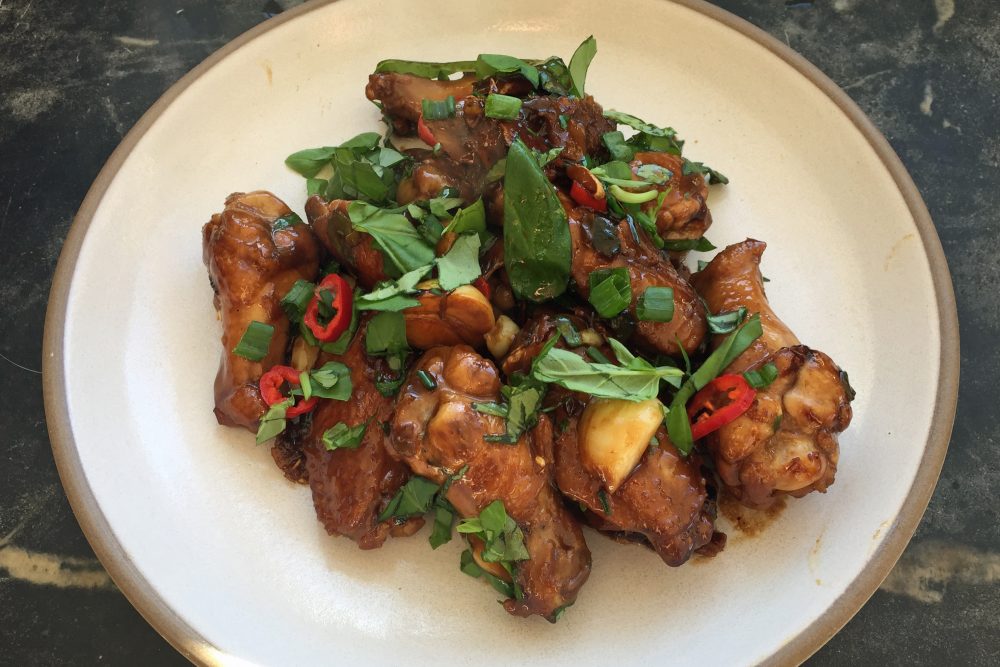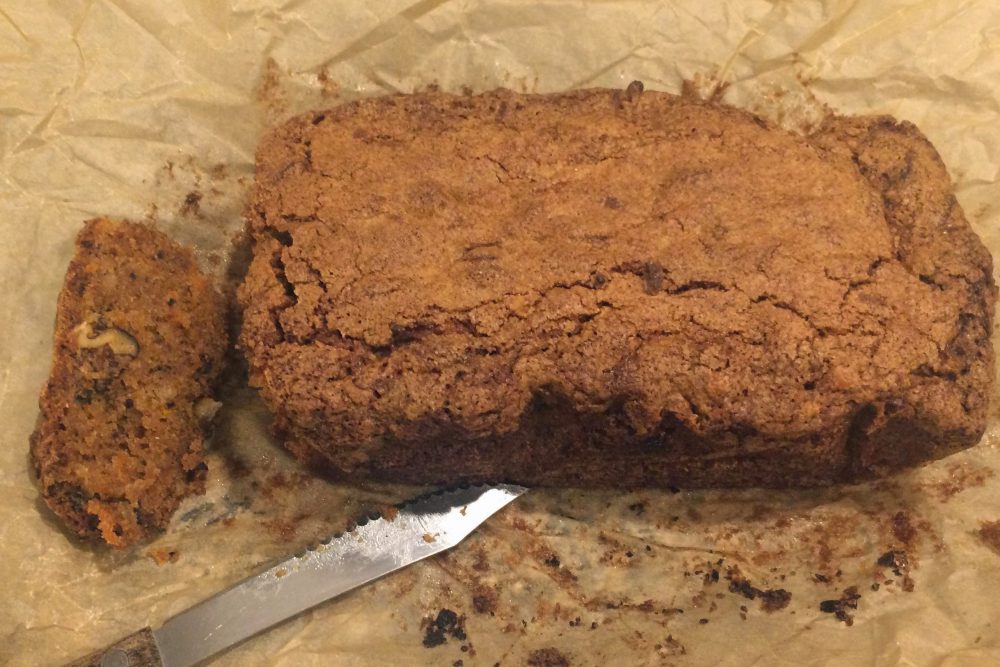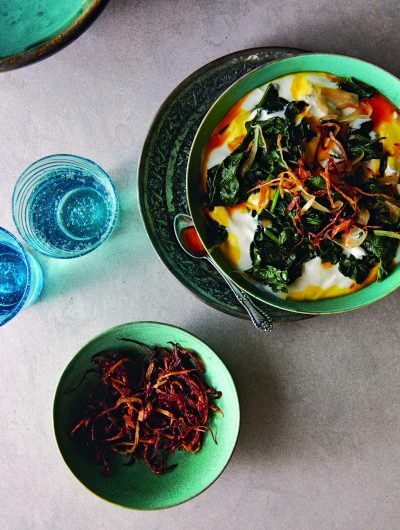Advertisement
7 Recipes From Resident Chef Kathy Gunst's Favorite Cookbooks Of 2016
Here & Now resident chef Kathy Gunst has been culling through this year’s crop of cookbooks to find the standouts. She brings Here & Now's Jeremy Hobson and Robin Young a few dishes from her favorites.
Below are recipes from four of Kathy's favorite 2016 cookbooks. You can also read Kathy's full reviews and find out about some of her additional picks.
Májiàng Miàn (Sesame Noodles)
By Carolyn Phillips, from "All Under Heaven: Recipes from the 35 Cuisines of China"
I have adored this simple street food ever since I took my first bite of it at a little stand on Nanhai Road, just a block or so away from my workplace. It was a very simple affair — just fresh noodles tossed with little more than toasted sesame paste, plus a dash of black vinegar, sugar, and soy sauce — but I always luxuriated over this quiet, solitary lunch.
Over the years I have messed around with this dish quite a bit, as I found it to be another one of those basic templates that ought to be tinkered with until you find your sweet spot. Peanut butter found its way into the mix to provide another layer of nutty creaminess and more complexity to the flavors. Garlic soon lent its fragrance, as did homemade chili oil with lots of goop, which can make this taste a whole lot like Sichuan’s dandan noodles (dāndānmiàn 擔擔麵). Like stone soup, this just gets better as more delicious things are added.
Ingredients
- 2 tablespoons toasted sesame oil or chili oil plus goop
- 2 tablespoons toasted sesame paste (homemade or store-bought)
- 2 tablespoons peanut butter, crunchy or smooth
- 1 or more cloves garlic (I like 2 cloves), finely chopped
- 1 green onion, trimmed and finely chopped, white and green in separate piles
- 1 ½ tablespoons regular soy sauce
- 1 tablespoon dark vinegar
- 1 teaspoon sugar
- 8 ounces dried wheat noodles of any kind
Instructions
- First make the sauce: in a wok, mix together the sesame oil (or chili oil and goop), sesame paste, peanut butter, garlic, onion whites, soy sauce, vinegar, and sugar. Heat this slowly over medium-low heat, stirring constantly, until the sauce is slightly cooked through, then taste and adjust the seasoning.
- Bring a saucepan filled with water to a boil, add the wheat noodles, and cook until barely done. Scoop out the noodles and add to the wok. Toss the noodles until they are all well coated, adding some of the hot pasta water as needed to keep them from clumping up. (To be honest, this will take more water than you expect.) Divide the noodles among the bowls, sprinkle on the onion greens, and serve hot. I like to offer small bowls of the cooking water on the side as a simple soup that can be used to thin down the sauce as needed.

Sānbēi jī (Three-Cup Chicken)
In Taipei, during the early 1980s, there was a strip of little dives at the upper end of Zhongshan North Road. This was in a neighborhood called Tianmu, a rather posh enclave where most of the foreigners lived. Unlike most of the area’s other establishments, which catered to expats, these “beer houses,” or píjĭu wū 啤酒屋, had a solidly Chinese clientele. They served what can best be described as Asian tapas. These little shacks were decorated with folk art and bamboo pan¬eling, and they offered lots of good beer. But the real draw was the food.
On Friday nights, my husband and I would some¬times meet friends at one end of the beer-house section and eat and drink our way up and down the hill. The dish I looked forward to the most was this Jiangxi recipe filtered through a Taiwanese lens. The bird was served on the bone with a sticky, savory sauce, as well as with plump garlic cloves, fresh chilies, green onions, chewy ginger slices, and a big handful of basil leaves. Serves 6 to 8.
Advertisement
Ingredients
- 2 pounds chicken wings
- 4 inches fresh ginger
- 16 cloves garlic
- ¼ cup peanut or vegetable oil
- ¼ cup oyster sauce or regular soy sauce
- 1 tablespoon rock sugar, optional for Jiangxi-style dish
- ¼ cup mild rice wine
- 1 tablespoon toasted sesame oil
- 4 green onions, trimmed and white parts cut into 1/2-inch-thick rounds and green parts diced
- 2 to 4 red jalapeño peppers or other red chili, trimmed and cut into thin rings or half-moons, optional
- 1 cup packed stemmed fresh basil leaves, large leaves roughly chopped, optional
Instructions
- Trim off the tip sections of the chicken wings (use these for stock) and cut the rest of each wing into 2 pieces. I also like to whack the wing pieces in half crosswise to make bite-sized morsels. Slice the ginger paper-thin; you should have about ½ cup. Peel the garlic cloves and trim off the hard ends but leave the cloves whole.
- Pour the peanut or vegetable oil into a sandpot and set it over medium heat. As soon as the oil starts to shimmer, toss in the ginger slices and fry them, stirring often, until they are golden and crispy; use a slotted spoon to remove them. Add the chicken to the ginger-scented oil and stir as you fry it until the chicken is golden all over. Pour in the oyster sauce or soy sauce and the optional sugar, rice wine, and sesame oil and toss in the fried ginger and the whites of the green onions.
- Bring the pot to a boil, cover it, adjust the heat to medium-low, and then simmer the chicken until it is tender and the sauce has been reduced by more than half. Add the garlic, re-cover, and continue to cook gently until only the oil remains at the bottom of the pot. The dish can be made ahead of time up to this point and reheated just before you add the final ingredients.
- Taste the sauce and adjust the seasoning. Toss in the optional chilies and the green parts of the onions. Sprinkle the optional basil over the top, place the lid back on the pot, and serve immediately.
The Taiwanese seasonings here are oyster sauce, green onions, chilies, and basil. Jiangxi style calls for soy sauce and rock sugar in place of the oyster sauce.
Reprinted with permission from ALL UNDER HEAVEN by Carolyn Phillips. Copyright © 2016. Published by Ten Speed Press, an imprint of Penguin Random House, LLC.

My Newest Chocolate Chip Cookies
By Dorie Greenspan, from "Dorie's Cookies"
My Classic Best Chocolate Chip Cookies (recipe below) have been my favorites for close to twenty years. I still love them, but when it comes to chocolate chip cookies, it’s hard to be constant. Recipes for chocolate chip cookies are like scarves — you’re always happy to have a new one. And so, here’s my new cookie. Not radically different from the old one... but different enough that you’ll want to make both.
This cookie, with its combination of all-purpose and whole wheat flours and a different mix of white and brown sugars, bakes to a chewier cookie than my classic. I added nutmeg and coriander to the dough, and it’s up to you if you’d like to use them or not — or if you’d like to use even more. Or maybe you want to flavor the dough with a little instant espresso (1/2 to ¾ teaspoon) with or without ground cinnamon (1/4 teaspoon), or even a little (1/4 to 1/2 teaspoon) Chinese five-spice powder.
A word on timing: You can use the dough soon after it’s made, but it improves with more chill time. If you can wait a day to bake the cookies, do. Makes about 50 cookies.
Ingredients
- 1 3/4 cups (238 grams) all-purpose flour
- 2/3 cup (91 grams) whole wheat flour
- 3/4 teaspoon baking soda
- 1/4 teaspoon freshly grated nutmeg
- 1/4 teaspoon ground coriander
- 2 sticks (8 ounces; 226 grams) unsalted butter, cut into chunks, at room temperature
- 1 cup (200 grams) sugar
- 3/4 cup (150 grams) packed light brown sugar
- 1 1/4 teaspoons fine sea salt
- 2 large eggs, at room temperature
- 2 teaspoons pure vanilla extract
- 10 ounces (283 grams) semisweet or bittersweet chocolate, coarsely chopped (or 1 2/3 cups chocolate chips)
Instructions
- Whisk both flours, the baking soda, nutmeg and coriander together.
- Working with a stand mixer fitted with the paddle attachment, or in a large bowl with a hand mixer, beat the butter, both sugars and the salt together on medium speed until smooth, about 3 minutes. One by one, add the eggs and beat for 1 minute after each goes in. Beat in the vanilla. Turn the mixer off, add the dry ingredients all at once and pulse to begin the blending, then mix on low speed until the dough comes together and the flour has disappeared. Add the chocolate and incorporate on low speed or mix in by hand with a sturdy flexible spatula. Wrap the dough in plastic and refrigerate it for at least 1 hour.
- Getting ready to bake: Position the racks to divide the oven into thirds and preheat it to 375 degrees F. Line two baking sheets with parchment paper or silicone baking mats.
- Using a tablespoon, scoop out level portions of dough. Roll each tablespoon of dough between your palms to make a ball and place the balls at least 2 inches apart on the lined baking sheets.
- Bake for 9 to 11 minutes, rotating the pans top to bottom and front to back after 6 minutes, or until the cookies have spread, puffed a little, turned a light golden brown and feel only just set around the edges. Transfer the baking sheets to racks and let the cookies rest on the sheets for at least 5 minutes before lifting them onto the racks to cool to just warm or room temperature.
- Repeat with the remaining dough, being certain to use cool baking sheets.
Storage Instructions
You can refrigerate the dough for up to 3 days. If you'd like, you can shape the dough into balls, place them on baking sheets, slide them into the freezer and then, when they’re solid, pack them airtight. Let them stand at room temperature while you preheat the oven. You can keep the baked cookies covered at room temperature for at least 5 days, or wrap airtight and freeze for up to 2 months.
My Classic Best Chocolate Chip Cookies
While very similar to my newest cookies, these are a thinner cookie with less chew. They also don’t have the new spice combination. (Of course, if you like the idea of nutmeg and coriander in your chippers, you can add them to this recipe.) The mixing method is the same.
Here are the ingredients: 2 cups all-purpose flour, 1 teaspoon fine sea salt, 3/4 teaspoon baking soda, 1 cup sugar, 2/3 cup packed light brown sugar, 2 teaspoons pure vanilla extract, 2 large eggs, 12 ounces bittersweet chocolate, finely chopped (or use chocolate chips), and 1 cup finely chopped walnuts or pecans.
I use a slightly rounded tablespoon of dough for each cookie and bake them in a 375 degree oven for 10 to 12 minutes.
Excerpted from DORIE’S COOKIES © 2016 by Dorie Greenspan. Republished by permission of Rux Martin/Houghton Mifflin Harcourt. All rights reserved.

Spiced Carrot And Walnut Cake
By Itamar Srulovich and Sarit Packer, from "Golden: Sweet & Savory Baked Delights from the Ovens of London's Honey & Co."
Makes a 2-pound, 2 1/2 by 4 1/2-inch loaf.
Instructions
- 80g walnuts
- 100g all-purpose flour
- 75g whole-wheat flour
- 1 teaspoon ground cinnamon
- 1 teaspoon ground ginger
- A pinch of table salt
- 1 teaspoon baking soda
- 3 carrots, peeled and grated (175g)
- 1 large apple, peeled and grated (50g)
- 250g granulated sugar
- 175g/185ml vegetable oil (such as sunflower or canola)
- 2 eggs
Instructions
- Preheat the oven to 375 degrees, or 350 degrees on convection.
- Butter an 8-by-4 inch loaf tin and line the base and long sides with a sheet of baking parchment, leaving a little overhang at the sides. Once the oven is hot, roast the walnuts for 10 minutes. Leave to cool a little before chopping roughly.
- Mix the flours, spices, salt and baking soda together in a bowl. In a separate bowl mix the grated carrot, grated apple and chopped nuts. Place the sugar and oil in a large bowl (or you could use a mixer with a whisk attachment if you are superlazy) and whisk together until combined. Whisk in the eggs one at a time and keep whisking until you have a lovely emulsified texture, a little like mayonnaise. Get rid of the whisk. Use a spatula or large spoon to stir in the carrots, apple and nuts. Fold in the remaining ingredients and combine to an even consistency.
- Transfer the batter to the lined loaf tin and bake for 35 minutes. Turn the tin around for an even bake and leave for a further 20 to 25 minutes. The end result should be lovely and springy to the touch.
- Allow to cool in the tin before removing. This will keep in an airtight container for up to 5 days.
Excerpted from GOLDEN. Copyright © 2016 by Itamar Srulovich and Sarit Packer. Used with permission of Little, Brown and Company, New York. All rights reserved.
Spinach Borani

By Naomi Duguid, from "Taste of Persia: A Cook's Travels Through Armenia, Azerbaijan, Georgia, Iran, and Kurdistan"
The Persian dishes called borani are a genius combination of cooked vegetable and thick drained yogurt. They are generally topped with fried onions, and often with a scattering of lightly toasted walnuts. People rave whenever I serve them, especially this spinach version. Serves 4 to 6.
Ingredients
- About 1 1/2 cups plain full-fat yogurt
- 2 pounds spinach
- About 2 tablespoons sunflower or extra-virgin olive oil
- 1 medium onion, thinly sliced
- 1 teaspoon sea salt, or to taste
- 1 tablespoon water
Optional Toppings
- About 1 tablespoon saffron water (see recipe below)
- 2 to 3 tablespoons coarsely chopped lightly toasted walnuts
Instructions
- Drain the yogurt to thicken it: Line a sieve or colander with cheesecloth or a cotton cloth. Moisten the cloth with water. Set the sieve or colander over a bowl and add the yogurt. Set aside, loosely covered, to drain for about 30 minutes.
- Meanwhile, trim the tough stems from the spinach. Wash the spinach thoroughly in several changes of water and drain well. Coarsely chop and set aside.
- Heat the oil in a wide heavy skillet over medium-high heat. Add the onion, lower the heat to medium, and fry the onion until translucent and touched with color, about 5 minutes. Transfer the onion to a plate and set aside.
- Raise the heat under the skillet to medium-high and add the spinach, turning it to expose it to the hot surface. Add about 1⁄2 cup water and cook, pressing and turning the spinach, until it is well wilted and deep green, 4 to 5 minutes. Transfer the spinach to a bowl to cool slightly.
- Once the spinach is cool enough to handle, squeeze it thoroughly, a handful at a time, to press out excess water.
- Transfer the spinach to a bowl, add 1/2 teaspoon salt, and mix well.
- Turn the thickened yogurt out into a bowl; you’ll have about 1 cup. Add the remaining 1⁄2 teaspoon salt and the water to loosen the yogurt slightly and stir. (Save the whey for another purpose or discard.) Add the yogurt to the spinach and stir gently to mix them a little, but not into a smooth blend, leaving the mixture with patches of white and dark green. Taste and adjust the seasoning if necessary.
- Strew on the fried onions, sprinkle with the saffron water and toasted walnuts if you wish, and serve.
Saffron Water
Once you find a good source of saffron — of saffron threads, as the stigmas are known — start using it. You can use them whole, but you get better color and aroma if you grind them to a powder. Just take a pinch and place it in a small mortar or bowl. Add a few grains of salt or sugar and use a pestle or the back of a spoon to grind the threads to a fine powder.
You can add saffron directly to a broth, but soaking it first in a little hot water is the best way to transform it into an effective flavoring and coloring, especially if you are using it to tint and flavor cooked rice. The proportions are roughly a generous pinch (1/4 teaspoon) of saffron threads to 1/4 cup hot water.
Pour the water over the threads or powder and stir. Transfer to a clean glass jar and let steep for at least 10 minutes, covered, before using it in a dish. As it sits, the color will deepen to a rich red-orange. Any leftover saffron water will keep in the refrigerator for a week or so, losing a little aroma over time.
Excerpted from TASTE OF PERSIA by Naomi Duguid (Artisan Books). Copyright © 2016. Photographs by Gentl & Hyers.